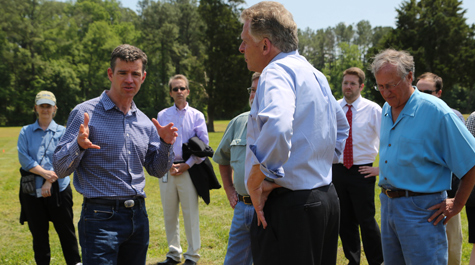Werowocomoco National Park? It would benefit both tourism and scholarship
Incorporating Werowocomoco into the National Park System would be a double boon, benefiting both Virginia tourism as well as scholarship, according to Martin Gallivan, the William & Mary archaeologist who led the excavation of the ancient site.
Reports that President Barack Obama had included a budget request for adding the site to the National Park Service prompted the gubernatorial visit to Chief Powhatan’s ancient Algonquin capital town on the north shore of the York River on May 20. Werowocomoco was a considerable town long before the settlers arrived at Jamestown. The story of Pocahontas’s intervention in John Smith’s execution is disputed by scholars—but if it happened, it happened at Werowocomoco, Gallivan says.
“A heritage site at Werowocomoco would begin to 'flip the script' from the focus on Jamestown and the English toward the deep, complicated history of the Powhatan chiefdom,” Gallivan said. “The National Park Service designates the places that really matter in American history. Werowocomoco deserves National Park status given its pivotal role in the Chesapeake's colonial history and its central place in the Powhatan world.”
Gallivan, a professor in the university’s Department of Anthropology, was among those who greeted a boat bearing a delegation led by Virginia Governor Terry McAuliffe to Werowocomoco on May 20. The delegation also included a number of Commonwealth officials, who boarded the boat at York River State Park. Gallivan said it was appropriate for the governor and his entourage to arrive by water.
“Water is a huge part of the power of this place,” Gallivan said. “The rivers were the interstate highways of the day. When John Smith arrived at Werowocomoco, he wasn’t taken down Route 17—he arrived by water like everyone else.”
Gallivan and Randy Turner, his recently retired counterpart in the Virginia, Department of Historic Resources, joined landowners Bob and Lynn Ripley, in conducting a tour of what was a thriving military and religious power center for hundreds of years. “Think of it as the Pentagon and the Vatican, rolled into one,” Gallivan says. They took the governor over the excavated parts of the city, now reburied for protection.
Gallivan is finishing up a book that deals extensively with Werowocomoco. Tentatively titled An Archaeological History of the Algonquian Chesapeake: From Tsenacomacoh to Werowocomoco, the book explores the physical layout of the town and the material culture recovered by archaeology to draw conclusions about the role of Powhatan’s city in the flow of power throughout Tsenacomacoh, the region controlled by the chief. Tsenacomacoh (sehn-uh-kuh-MAH-kah) was an area that stretched from south of the James to the Potomac and from the Eastern Shore west to where I 95 runs today.
“The argument that I make in my book is that Werowocomoco was laid out in a way to convey the power of central leaders, or werowances, in the Algonquian world,” Gallivan said. “That interpretation is new and is a result of the archaeology that we’ve been doing at Werowocomoco.”
Julie Langan, director of the Virginia Department of Historic Resources, said the governor’s visit to the site was scheduled to last 30 minutes, but he stayed for more than an hour, asking questions of the archaeologists and talking about state and federal cooperation to bring the site into the National Park System. “He was really pumped up,” Langan said.
Gallivan says he shares McAuliffe’s enthusiasm for the prospect of Werowocomoco joining the national park service. He said the NPS-administered Historic Jamestowne would be an excellent model for Werowocomoco, a location that could incorporate continuing archaeological work with interpretive displays for the public. There is an immense amount of work that can be done to get a fuller understanding of the site, he said.
“Our excavations have barely scratched the surface. We’ve excavated approximately three percent of the town of Werowocomoco,” Gallivan said.
Archaeologists have long known that the site was somewhere along the York River’s Purtan Bay, but the precise location of Werowocomoco came to light around 15 years ago, when Lynn Ripley began finding an enormous number of pre-contact artifacts on her land. Archaeological examination of the site began shortly thereafter. In 2003, Gallivan and Danielle Moretti-Langholtz, research assistant professor of anthropology, met with leaders of the eight Virginia Indian tribes with links to Werowocomoco.
The scholars incorporated representatives of the tribes as advisors in the Werowocomoco Research Group, based at William & Mary. Virginia Indians have been involved in excavation and interpretation of the site from the earliest stages of the research. Representatives of each tribe spoke at a June, 2013 event marking the signing of a conservation easement, which protected the archaeologically significant portions of the property from development.
Gallivan says that it is essential to include representatives of the descendant peoples in the incorporation of Werowocomoco into the National Park System.
“Native communities have lived in the Chesapeake region for thousands of years,” Gallivan explained. “My colleagues and I have worked closely with Powhatan descendants, a number of whom have urged us to orient our research toward historical developments older than and distinct from John Smith’s account of his rescue, stories that dominate conversations about the Native past. We can’t begin to understand the full story without this deeper historical perspective.”
















